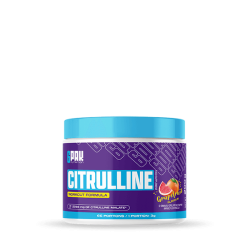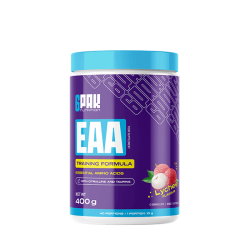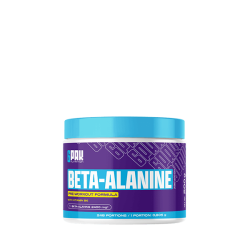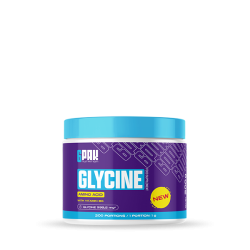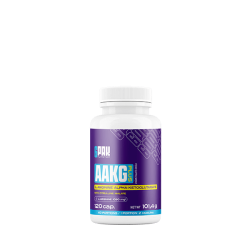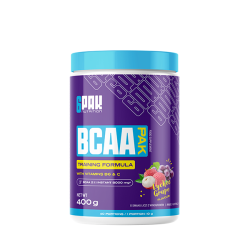Citrulline - Cytrulina w proszku
-
Kategorie
-
-
-
-
ODŻYWKI I SUPLEMENTY
-
-
-
-
ZDROWIE I WITAMINY
-
-
-
-
-
-
AKCESORIA
-
-
-
-
NASZE LINIE PRODUKTÓW
-
-
-
-
Podkategorie
Aminokwasy
Aminokwasy a białka
Z chemicznego punktu widzenia białka są jednymi z najbardziej złożonych strukturalnie i funkcjonalnie cząsteczek. Pomyśl tylko, że struktura i chemia każdego białka była rozwijana i dopracowywana przez miliardy lat historii ewolucyjnej. W białkach znajduje się 20 rodzajów aminokwasów, każdy o innych właściwościach chemicznych. Cząsteczka białka składa się z długiego łańcucha tych aminokwasów, z których każdy jest połączony ze swoim sąsiadem kowalencyjnym wiązaniem peptydowym. Białka są zatem znane również jako polipeptydy. Każdy rodzaj białka ma unikalną sekwencję aminokwasów, dokładnie taką samą w każdej cząsteczce. Znanych jest wiele tysięcy różnych białek, z których każde ma swoją własną sekwencję aminokwasową. To wystarczy, żeby uświadomić nam jak ważne są aminokwasy.
Co to są aminokwasy?
Zarówno białka zwierzęce, jak i roślinne składają się z około 20 typowych aminokwasów. Proporcja tych aminokwasów różni się w zależności od właściwości danego białka, ale wszystkie białka spożywcze – z wyjątkiem żelatyny – zawierają po części każdego z nich. Aminokwasy są niezbędne do syntezy białek ustrojowych i innych ważnych związków zawierających azot, takich jak kreatyna, hormony peptydowe i niektóre neuroprzekaźniki. Białka pełnią różnorodne funkcje w organizmie, w tym replikacja DNA, transport cząsteczek, katalizowanie reakcji metabolicznych i zapewnianie wsparcia strukturalnego komórkom. Chociaż zapotrzebowanie określamy na białko, tak naprawdę biologicznym wymogiem są aminokwasy.
Czy aminokwasy są potrzebne?
Tak! I to ciągle, przez całe nasze życie. Białka i inne związki azotowe ulegają stałej degradacji i ponownej syntezie. Kilka razy więcej białka jest przekształcane w organizmie każdego dnia, niż jest normalnie spożywane, co wskazuje, że ponowne wykorzystanie aminokwasów jest główną cechą ekonomii metabolizmu białka. Ten proces odzyskiwania nie jest całkowicie wydajny, a niektóre aminokwasy są tracone w wyniku katabolizmu oksydacyjnego. Produkty metaboliczne aminokwasów (mocznik, kreatynina, kwas moczowy i inne produkty azotowe) są wydalane z moczem; azot jest również tracony w kale, pocie i innych wydzielinach ciała oraz w złuszczonej skórze, włosach i paznokciach. Aby uzupełnić te straty, konieczne jest ciągłe dostarczanie aminokwasów w naszej diecie, nawet po zakończeniu wieku, kiedy intensywnie rośniemy.
Aminokwasy egzogenne i aminokwasy endogenne
Istnieje kilka kryteriów podziału aminokwasów. Skupimy się tutaj na najpopularniejszym podziale, o którym na pewno słyszałeś. Wyróżniamy:
- Aminokwasy, których organizm nie jest w stanie sam syntetyzować lub tempo syntezy nie odpowiada odpowiednio zapotrzebowaniu organizmu i muszą być przyjmowane z pożywieniem – określane są jako aminokwasy egzogenne lub niezbędne;
- Aminokwasy, które nasz organizm jest w stanie syntetyzować – określane są jako aminokwasy endogenne lub nie niezbędne (wytwarzane są z innych aminokwasów, czy też z produktów przemian węglowodanów, tłuszczów).
Czym są EAA?
Dziewięć aminokwasów jest uważanych za aminokwasy egzogenne (EAA). Są one niezbędne dla nowych struktur białkowych i nie mogą być wytwarzane przez organizm w fizjologicznie znaczących ilościach, dlatego muszą być dostarczane jako kluczowe składniki zbilansowanej diety. EAA obejmują histydynę, izoleucynę, leucynę, walinę, lizynę, treoninę, fenyloalaninę, metioninę i tryptofan. Trzy z dziewięciu EAA (leucyna, walina i izoleucyna) to aminokwasy rozgałęzione (BCAA). Pozostałe 11 aminokwasów to aminokwasy warunkowo niezbędne i endogenne do których należy: glicyna, alanina, arginina, asparagina, kwas asparaginowy, glutamina, kwas glutaminowy, prolina, seryna oraz tyrozyna, cysteina.
Co to jest BCAA? Czy BCAA działa?
Aminokwasy rozgałęzione (Branched Chain Amino Acid – BCAA), czyli leucyna, izoleucyna i walina to trzy z dziewięciu aminokwasów niezbędnych (EAA). Leucyna jest nie tylko prekursorem syntezy białek mięśniowych, ale może również odgrywać rolę regulatora wewnątrzkomórkowych szlaków sygnałowych, które są zaangażowane w proces syntezy białek. BCAA wyróżniają się wśród niezbędnych aminokwasów tym, że nie są metabolizowane w wątrobie, a w mięśniach szkieletowych. Koncepcję, że aminokwasy rozgałęzione mogą mieć wyjątkową zdolność do stymulowania syntezy białek mięśniowych, przedstawiano już ok. 40 lat temu. A czy wiesz, że wyniki badań nadal pozostają niejednoznaczne i dyskusja czy BCAA faktycznie działają wciąż trwa? Już lata temu sugerowano, że suplementacja BCAA może zmniejszać degradację białek i/lub uwalnianie enzymów mięśniowych, zmniejszać uszkodzenia mięśni szkieletowych w odpowiedzi na intensywne ćwiczenia oporowe, łagodzić zmęczenie centralne i promować późniejszą regenerację funkcji mięśni. Badania nadal trwają. Jednakże biorąc pod uwagę wszystkie mechanizmy fizjologiczne związane ze stosowaniem BCAA oraz fakt, że są metabolizowane głównie w mięśniach szkieletowych, podczas gdy inne niezbędne aminokwasy są katabolizowane w wątrobie – suplementacja BCAA została uznana za potencjalną strategię żywieniową.
Arginina i cytrulina, czyli aminokwasy kojarzone z pompą mięśniową
Tlenek azotu odgrywa ważną rolę w naszym organizmie. Znany jest z tego, że rozszerza naczynia krwionośne, poprawiając krążenie i poprawiając wydajność mitochondriów. Wywiera szereg funkcji fizjologicznych [np. zwiększa wydolność kurczliwości mięśni, poprawia tolerancję wysiłku i reguluje zużycie tlenu]. L-arginina jest prekursorem, z którego w komórkach śródbłonka jest syntetyzowany tlenek azotu. Zwiększenie ilości L-argininy w krążeniu może stanowić potencjalny mechanizm zwiększający syntezę tlenku azotu i biodostępności. Okazuje się jednak, że L-cytrulina ma zdolność do zwiększania dostępności L-argininy do produkcji tlenku azotu. Co w takim razie daje nam cytrulina? Uważa się, że suplementacja cytruliny jest tak samo wydajna, jeśli nie bardziej wydajna niż sama suplementacja argininy w zwiększaniu produkcji tlenku azotu.
A co z AAKG?
Jak wspomniano powyżej, ilość L-argininy w organizmie może być etapem ograniczającym tempo produkcji tlenku azotu. Ostatnio coraz popularniejsze stają się suplementy diety, w których L-arginina połączona jest z alfa-ketoglutaranem (AAKG). Alfa-ketoglutaran to związek, który odgrywa ważną rolę w metabolizmie i bierze udział w wielu reakcjach biochemicznych, w tym produkcji energii i syntezie aminokwasów. Związek ten często występuje w suplementach diety, zwłaszcza w połączeniu z L-argininą. Egzogenna podaż alfa-ketoglutaranu poprzez suplement taki jak alfa-ketoglutaran L-argininy (AAKG) może zwiększyć przepływ cyklu Krebsa. Alfa-ketoglutaran może mieć działanie oszczędzające glutaminian w organizmie. Jest to ważne, ponieważ alfa-ketoglutaran może być uzupełniany poprzez transaminację (odpowiednią reakcję chemiczną) glutaminianu, który jest aminokwasem niezbędnym do anabolizmu białek; znanym również jako bardzo ważny neuroprzekaźnik pobudzający układ nerwowy.
Czym jest glutamina?
Ciekawostką jest to, że spośród 20 aminokwasów wyszczególnionych w kodzie genetycznym, glutamina stanowi najlepszy przykład wszechstronności metabolizmu aminokwasów. Glutamina jest najbardziej rozpowszechnionym i wielokierunkowym aminokwasem w organizmie i ma fundamentalne znaczenie dla różnych funkcji biologicznych, takich jak m.in. proliferacja komórek, produkcja energii, glikogeneza, buforowanie amoniaku, utrzymanie równowagi kwasowo-zasadowej. W prawie każdej komórce glutamina może być stosowana jako substrat m. in. do syntezy nukleotydów (puryny, pirymidyny i aminocukry), przeciwutleniaczy i wielu innych szlaków biosyntezy zaangażowanych w utrzymanie integralności i funkcji komórki. Glutamina jest warunkowo niezbędnym aminokwasem szeroko stosowanym w żywieniu osób aktywnych fizycznie i profesjonalnych sportowców.
Nie zapominajmy o beta-alaninie
Beta-alanina jest jednym z najczęściej stosowanych suplementów sportowych na świecie. Zwiększa ona wewnątrzkomórkową zdolność buforowania, mając potencjalnie korzystny wpływ na trwałą wydajność ćwiczeń o wysokiej intensywności. Co ciekawe, sama w sobie ma ograniczone właściwości ergogeniczne; jednak beta-alanina została zidentyfikowana jako ograniczający szybkość prekursor syntezy karnozyny i konsekwentnie wykazano, że zwiększa poziom karnozyny w ludzkich mięśniach szkieletowych. Podstawową rolą karnozyny w metabolizmie mięśni szkieletowych jest działanie jako bufor wewnątrzkomórkowy – oznacza to, że wykazuje wpływ na zachowanie optymalnego pH. A jak to działa? Otóż podczas wykonywania ćwiczeń o dużej intensywności, ze względu na dominujący układ energetyczny (beztlenowy metabolizm węglowodanów), dochodzi do wysokiego uwalniania protonów wodoru (H+), co prowadzi do obniżenia pH. Ten spadek pH może negatywnie wpływać na procesy metaboliczne, które przyczyniają się do wystąpienia zmęczenia mięśni. Karnozyna znajduje się w tkance mięśniowej i działa jako bufor protonów wodoru w krótkotrwałych ćwiczeniach fizycznych o wysokiej intensywności. To taka natychmiastowa obrona przed akumulacją protonów w kurczących się mięśniach podczas wysiłku.
Aminokwasy od 6PAK Nutrition
Jeśli jeszcze nie wiesz, które aminokwasy wybrać z naszej oferty – oto krótka ściąga :)
- EAA – czyli zestaw niezbędnych aminokwasów egzogennych to idealny produkt okołotreningowy. Pamiętaj jak ważne są aminokwasy dla organizmu człowieka, a zwłaszcza dla organizmu, który prowadzi aktywny tryb życia i intensywne treningi. EAA uwzględnia też w swoim składzie BCAA, czyli aminokwasy rozgałęzione w optymalnej proporcji 2:1:1. Nie wiesz na jaki produkt aminokwasowy się zdecydować? EAA będzie strzałem w dziesiątkę!
- BCAA – aminokwasy rozgałęzione (czyli L-leucyna, L-izoleucyna i L-walina) w optymalnej proporcji 2:1:1. Produkt został dodatkowo wzbogacony o witaminę C i dwie witaminy z grupy B: B6 i B12. Jeśli wybierasz się na trening – BCAA będą zawsze dobrym wyborem. Instanizowana forma aminokwasów gwarantuje świetną rozpuszczalność. BCAA od 6PAK na pewno Cię nie rozczaruje!
- Anticatabolic – to również produkt, w którym znajdziesz aminokwasy BCAA w proporcji 2:1:1. Ale to nie wszystko! Skład również obejmuje L-glutaminę i taurynę oraz dodatek witamin: C i B6. Świetna propozycja na dzień treningowy – pół porcji wypijasz przed treningiem, a resztę w trakcie treningu. Znakomicie opracowana formuła – będzie Pan zadowolony! Anticatabolic robi robotę!
- Glutamine – czyli tak naprawdę połączenie trzech składników aktywnych: L-glutaminy, tauryny i witaminy B6 w świetnie dobranych proporcjach. To produkt do stosowania przed i po treningu. Jeśli nie wiesz jaką formułę okołotreningową wybrać – wypróbuj Glutamine. Trzeba tutaj jeszcze wspomnieć, że to produkt w proszku w wersji bezsmakowej, ale za to skład bazuje wyłącznie na 3 składnikach – nie znajdziesz tutaj żadnych substancji dodatkowych.
- Beta-alanine – beta alanina w postaci proszku z dodatkiem witaminy B6. To produkt stworzony z myślą o osobach ze zwiększoną aktywnością fizyczną. Jedna porcja to 800 mg beta-alaniny – zaleca się stosowanie do 3 takich porcji dziennie. Ale spokojnie, opakowanie jest wydajne – zapewnia w sumie aż 248 porcji! Z Beta-alanine żaden trening nie będzie zbyt ciężki!
- Citrulline – jabłczan cytruliny w postaci proszku. Malutka miarka (tylko 3 g), a może przenieść Twój trening na inny poziom. Cytrulina znakomicie sprawdzi się jako przedtreningówka. To produkt z jednym składnikiem aktywnym, ale może Cię zaskoczyć. Postaw na Citrulline!
- AAKG – w naszej ofercie znajdziesz alfa-ketoglutaran L-argininy w postaci proszku i w postaci tabletek, czyli dla każdego coś dobrego. Oprócz tego opcja w proszku została dodatkowo wzbogacona o taurynę i witaminę B6. Po prostu znajdź w swoim planie treningowym miejsce dla AAKG (proszek lub tabletki – jak wolisz) i ciesz się z efektów swojej ciężkiej pracy.
Literatura:
- Alberts B., Johnson A., Lewis J., et al. Molecular Biology of the Cell. 4th edition. New York: Garland Science; 2002. The Shape and Structure of Proteins. Available from: https://www.ncbi.nlm.nih.gov/books/NBK26830/
- Jarosz M., Rychlik E., Stoś K., Charzewska J. (red.), Normy żywienia dla populacji Polski i ich zastosowanie, Narodowy Instytut Zdrowia Publicznego – Państwowy Zakład Higieny, 2020, s. 48-49.
- Sanvictores T., Farci F., Biochemistry, Primary Protein Structure. In: StatPearls [Internet]. Treasure Island (FL): StatPearls Publishing; 2022 Jan-. Available from: https://www.ncbi.nlm.nih.gov/books/NBK564343/
- National Research Council (US) Subcommittee on the Tenth Edition of the Recommended Dietary Allowances. Recommended Dietary Allowances: 10th Edition. Washington (DC): National Academies Press (US); 1989. 6, Protein and Amino Acids. Available from: https://www.ncbi.nlm.nih.gov/books/NBK234922/
- Church D. D., Hirsch K. R., Park S., Kim I. Y., Gwin J. A., Pasiakos S. M., Wolfe R. R., Ferrando A. A., Essential Amino Acids and Protein Synthesis: Insights into Maximizing the Muscle and Whole-Body Response to Feeding, Nutrients, 2020, 12(12), 3717.
- Górska-Warsewicz H., Laskowski W., Kulykovets O., Kudlińska-Chylak A., Czeczotko M., Rejman K., Food Products as Sources of Protein and Amino Acids-The Case of Poland. Nutrients, 2018, 10(12), 1977.
- VanDusseldorp T. A., Escobar K. A., Johnson K. E., Stratton M. T., Moriarty T., Cole N., McCormick J. J., Kerksick C. M., Vaughan R. A., Dokladny K., Kravitz L., Mermier C. M., Effect of Branched-Chain Amino Acid Supplementation on Recovery Following Acute Eccentric Exercise. Nutrients, 2018, 10(10), 1389.
- Wolfe R. R., Branched-chain amino acids and muscle protein synthesis in humans: myth or reality?. Journal of the International Society of Sports Nutrition, 2017, 14, 30.
- Fouré A., Bendahan D., Is Branched-Chain Amino Acids Supplementation an Efficient Nutritional Strategy to Alleviate Skeletal Muscle Damage? A Systematic Review. Nutrients, 2017, 9(10), 1047.
- Agarwal U., Didelija I. C., Yuan Y., Wang X., Marini J. C., Supplemental Citrulline Is More Efficient Than Arginine in Increasing Systemic Arginine Availability in Mice. The Journal of Nutrition, 2017, 147(4), 596-602.
- Allerto T. D., Proctor D. N., Stephens J. M., Dugas T. R., Spielmann G., Irving B. A. L-Citrulline Supplementation: Impact on Cardiometabolic Health. Nutrients, 2018, 10(7), 921.
- Wax B., Kavazis A. N., Webb H. E., Brown S. P., Acute L-arginine alpha ketoglutarate supplementation fails to improve muscular performance in resistance trained and untrained men. Journal of the International Society of Sports Nutrition, 2012, 9(1), 17.
- Kaczka P., Kubicka K., Batra A., Maciejczyk M., Kopera E., Bira J., Zając T., Effects of Co-Ingestion of β-Hydroxy-β-Methylbutyrate and L-Arginine α-Ketoglutarate on Jump Performance in Young Track and Field Athletes. Nutrients, 2021, 13(4), 1064.
- Cruzat V., Macedo Rogero M., Noel Keane K., Curi R., Newsholme P., Glutamine: Metabolism and Immune Function, Supplementation and Clinical Translation. Nutrients, 2018, 10(11), 1564.
- Coqueiro A. Y., Rogero M. M., Tirapegui J., Glutamine as an Anti-Fatigue Amino Acid in Sports Nutrition. Nutrients, 2019, 11(4), 863.
- Dolan E., Swinton P. A., Painelli V. S., Stephens Hemingway B., Mazzolani B., Infante Smaira F., Saunders B., Artioli G. G., Gualano B., A Systematic Risk Assessment and Meta-Analysis on the Use of Oral β-Alanine Supplementation. Advances in Nutrition (Bethesda, Md.), 2019, 10(3), 452-463.
- Maughan R. J., Burke L. M., Dvorak J., Larson-Meyer D. E., Peeling P., Phillips S. M., Rawson E. S., Walsh N. P., Garthe I., Geyer H., Meeusen R., van Loon L., Shirreffs S. M., Spriet L. L., Stuart M., Vernec A., Currell K., Ali V. M., Budgett R. G., Ljungqvist A., … Engebretsen, L., IOC consensus statement: dietary supplements and the high-performance athlete. British Journal of Sports Medicine, 52(7), 439-455.
- Trexler E. T., Smith-Ryan A. E., Stout J. R., Hoffman J. R., Wilborn C. D., Sale C., Kreider R. B., Jäger R., Earnest C. P., Bannock L., Campbell B., Kalman D., Ziegenfuss T. N., Antonio J., International society of sports nutrition position stand: Beta-Alanine. Journal of the International Society of Sports Nutrition, 2015, 12, 30.
Sprzedającym jest Trec Nutrition spółka z ograniczoną odpowiedzialnością z siedzibą w Gdyni, ul. Śmidowicza 48, 81-127 Gdynia, wpisaną do rejestru przedsiębiorców pod numerem KRS 0000315748, NIP: 9581602454, numer REGON 220696468
Copyright © 2025. Trec Nutrition Sp. z o.o... All rights reserved
check_circle
check_circle
